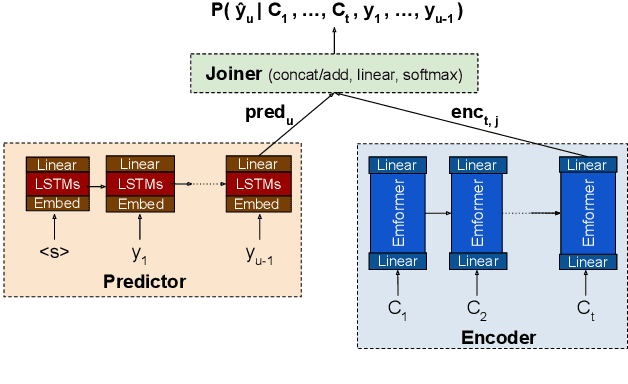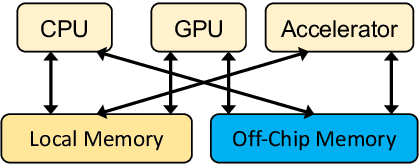Changsheng Zhao
ParetoQ: Scaling Laws in Extremely Low-bit LLM Quantization
Feb 04, 2025Abstract:The optimal bit-width for achieving the best trade-off between quantized model size and accuracy has been a subject of ongoing debate. While some advocate for 4-bit quantization, others propose that 1.58-bit offers superior results. However, the lack of a cohesive framework for different bits has left such conclusions relatively tenuous. We present ParetoQ, the first unified framework that facilitates rigorous comparisons across 1-bit, 1.58-bit, 2-bit, 3-bit, and 4-bit quantization settings. Our findings reveal a notable learning transition between 2 and 3 bits: For 3-bits and above, the fine-tuned models stay close to their original pre-trained distributions, whereas for learning 2-bit networks or below, the representations change drastically. By optimizing training schemes and refining quantization functions, ParetoQ surpasses all previous methods tailored to specific bit widths. Remarkably, our ParetoQ ternary 600M-parameter model even outperforms the previous SoTA ternary 3B-parameter model in accuracy, using only one-fifth of the parameters. Extensive experimentation shows that ternary, 2-bit, and 3-bit quantization maintains comparable performance in the size-accuracy trade-off and generally exceeds 4-bit and binary quantization. Considering hardware constraints, 2-bit quantization offers promising potential for memory reduction and speedup.
Llama Guard 3-1B-INT4: Compact and Efficient Safeguard for Human-AI Conversations
Nov 18, 2024Abstract:This paper presents Llama Guard 3-1B-INT4, a compact and efficient Llama Guard model, which has been open-sourced to the community during Meta Connect 2024. We demonstrate that Llama Guard 3-1B-INT4 can be deployed on resource-constrained devices, achieving a throughput of at least 30 tokens per second and a time-to-first-token of 2.5 seconds or less on a commodity Android mobile CPU. Notably, our experiments show that Llama Guard 3-1B-INT4 attains comparable or superior safety moderation scores to its larger counterpart, Llama Guard 3-1B, despite being approximately 7 times smaller in size (440MB).
LongVU: Spatiotemporal Adaptive Compression for Long Video-Language Understanding
Oct 22, 2024



Abstract:Multimodal Large Language Models (MLLMs) have shown promising progress in understanding and analyzing video content. However, processing long videos remains a significant challenge constrained by LLM's context size. To address this limitation, we propose LongVU, a spatiotemporal adaptive compression mechanism thats reduces the number of video tokens while preserving visual details of long videos. Our idea is based on leveraging cross-modal query and inter-frame dependencies to adaptively reduce temporal and spatial redundancy in videos. Specifically, we leverage DINOv2 features to remove redundant frames that exhibit high similarity. Then we utilize text-guided cross-modal query for selective frame feature reduction. Further, we perform spatial token reduction across frames based on their temporal dependencies. Our adaptive compression strategy effectively processes a large number of frames with little visual information loss within given context length. Our LongVU consistently surpass existing methods across a variety of video understanding benchmarks, especially on hour-long video understanding tasks such as VideoMME and MLVU. Given a light-weight LLM, our LongVU also scales effectively into a smaller size with state-of-the-art video understanding performance.
Agent-as-a-Judge: Evaluate Agents with Agents
Oct 14, 2024



Abstract:Contemporary evaluation techniques are inadequate for agentic systems. These approaches either focus exclusively on final outcomes -- ignoring the step-by-step nature of agentic systems, or require excessive manual labour. To address this, we introduce the Agent-as-a-Judge framework, wherein agentic systems are used to evaluate agentic systems. This is an organic extension of the LLM-as-a-Judge framework, incorporating agentic features that enable intermediate feedback for the entire task-solving process. We apply the Agent-as-a-Judge to the task of code generation. To overcome issues with existing benchmarks and provide a proof-of-concept testbed for Agent-as-a-Judge, we present DevAI, a new benchmark of 55 realistic automated AI development tasks. It includes rich manual annotations, like a total of 365 hierarchical user requirements. We benchmark three of the popular agentic systems using Agent-as-a-Judge and find it dramatically outperforms LLM-as-a-Judge and is as reliable as our human evaluation baseline. Altogether, we believe that Agent-as-a-Judge marks a concrete step forward for modern agentic systems -- by providing rich and reliable reward signals necessary for dynamic and scalable self-improvement.
Scaling Parameter-Constrained Language Models with Quality Data
Oct 04, 2024



Abstract:Scaling laws in language modeling traditionally quantify training loss as a function of dataset size and model parameters, providing compute-optimal estimates but often neglecting the impact of data quality on model generalization. In this paper, we extend the conventional understanding of scaling law by offering a microscopic view of data quality within the original formulation -- effective training tokens -- which we posit to be a critical determinant of performance for parameter-constrained language models. Specifically, we formulate the proposed term of effective training tokens to be a combination of two readily-computed indicators of text: (i) text diversity and (ii) syntheticity as measured by a teacher model. We pretrained over $200$ models of 25M to 1.5B parameters on a diverse set of sampled, synthetic data, and estimated the constants that relate text quality, model size, training tokens, and eight reasoning task accuracy scores. We demonstrated the estimated constants yield +0.83 Pearson correlation with true accuracies, and analyzed it in scenarios involving widely-used data techniques such as data sampling and synthesis which aim to improve data quality.
BUPTCMCC-6G-CMG+: A GBSM-Based ISAC Channel Model Simulator
Sep 22, 2024



Abstract:Integrated Sensing and Communication (ISAC) is one of the key technologies in 6G, and related research and standardization efforts are progressing vigorously. Wireless channel simulation is the cornerstone for the evaluation and optimization of wireless communication technologies. This paper proposes a design and implementation method for an ISAC channel simulation based on a Geometry-Based Stochastic Model (GBSM) simulation framework. First, we introduce the progress of 3GPP ISAC channel standardization and the key topics of discussion. Second, addressing the current lack of a standardized ISAC channel simulation framework, we propose a cascaded ISAC channel simulation framework based on GBSM, leveraging our team's related measurements, analyses, and proposal results. Based on this framework, we develop and design the ISAC channel simulator BUPTCMCC-6G-CMG+. Finally, we analyze and validate the simulation platform results, and provide some prospects for future ISAC testing research combined with channel simulators.
SpinQuant: LLM quantization with learned rotations
May 28, 2024



Abstract:Post-training quantization (PTQ) techniques applied to weights, activations, and the KV cache greatly reduce memory usage, latency, and power consumption of Large Language Models (LLMs), but may lead to large quantization errors when outliers are present. Recent findings suggest that rotating activation or weight matrices helps remove outliers and benefits quantization. In this work, we identify a collection of applicable rotation parameterizations that lead to identical outputs in full-precision Transformer architectures, and find that some random rotations lead to much better quantization than others, with an up to 13 points difference in downstream zero-shot reasoning performance. As a result, we propose SpinQuant that optimizes (or learns) the rotation matrices with Cayley optimization on a small validation set. With 4-bit quantization of weight, activation, and KV-cache, SpinQuant narrows the accuracy gap on zero-shot reasoning tasks with full precision to merely 2.9 points on the LLaMA-2 7B model, surpassing LLM-QAT by 19.1 points and SmoothQuant by 25.0 points. SpinQuant also outperforms concurrent work QuaRot, which applies random rotations to remove outliers. In particular, for LLaMA-2 7B/LLaMA-3 8B models that are hard to quantize, SpinQuant reduces the gap to full precision by 30.2%/34.1% relative to QuaRot.
Basis Selection: Low-Rank Decomposition of Pretrained Large Language Models for Target Applications
May 24, 2024Abstract:Large language models (LLMs) significantly enhance the performance of various applications, but they are computationally intensive and energy-demanding. This makes it challenging to deploy them on devices with limited resources, such as personal computers and mobile/wearable devices, and results in substantial inference costs in resource-rich environments like cloud servers. To extend the use of LLMs, we introduce a low-rank decomposition approach to effectively compress these models, tailored to the requirements of specific applications. We observe that LLMs pretrained on general datasets contain many redundant components not needed for particular applications. Our method focuses on identifying and removing these redundant parts, retaining only the necessary elements for the target applications. Specifically, we represent the weight matrices of LLMs as a linear combination of base components. We then prune the irrelevant bases and enhance the model with new bases beneficial for specific applications. Deep compression results on the Llama 2-7b and -13B models, conducted on target applications including mathematical reasoning and code generation, show that our method significantly reduces model size while maintaining comparable accuracy to state-of-the-art low-rank compression techniques.
MobileLLM: Optimizing Sub-billion Parameter Language Models for On-Device Use Cases
Feb 22, 2024Abstract:This paper addresses the growing need for efficient large language models (LLMs) on mobile devices, driven by increasing cloud costs and latency concerns. We focus on designing top-quality LLMs with fewer than a billion parameters, a practical choice for mobile deployment. Contrary to prevailing belief emphasizing the pivotal role of data and parameter quantity in determining model quality, our investigation underscores the significance of model architecture for sub-billion scale LLMs. Leveraging deep and thin architectures, coupled with embedding sharing and grouped-query attention mechanisms, we establish a strong baseline network denoted as MobileLLM, which attains a remarkable 2.7%/4.3% accuracy boost over preceding 125M/350M state-of-the-art models. Additionally, we propose an immediate block-wise weight sharing approach with no increase in model size and only marginal latency overhead. The resultant models, denoted as MobileLLM-LS, demonstrate a further accuracy enhancement of 0.7%/0.8% than MobileLLM 125M/350M. Moreover, MobileLLM model family shows significant improvements compared to previous sub-billion models on chat benchmarks, and demonstrates close correctness to LLaMA-v2 7B in API calling tasks, highlighting the capability of small models for common on-device use cases.
Not All Weights Are Created Equal: Enhancing Energy Efficiency in On-Device Streaming Speech Recognition
Feb 20, 2024



Abstract:Power consumption plays an important role in on-device streaming speech recognition, as it has a direct impact on the user experience. This study delves into how weight parameters in speech recognition models influence the overall power consumption of these models. We discovered that the impact of weight parameters on power consumption varies, influenced by factors including how often they are invoked and their placement in memory. Armed with this insight, we developed design guidelines aimed at optimizing on-device speech recognition models. These guidelines focus on minimizing power use without substantially affecting accuracy. Our method, which employs targeted compression based on the varying sensitivities of weight parameters, demonstrates superior performance compared to state-of-the-art compression methods. It achieves a reduction in energy usage of up to 47% while maintaining similar model accuracy and improving the real-time factor.
 Add to Chrome
Add to Chrome Add to Firefox
Add to Firefox Add to Edge
Add to Edge